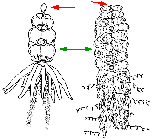CaRMS taxon details
Physonectae
- Family Agalmatidae Brandt, 1835
- Family Apolemiidae Huxley, 1859
- Family Cordagalmatidae Pugh, 2016
- Family Forskaliidae Haeckel, 1888
- Family Physophoridae Eschscholtz, 1829
- Family Pyrostephidae Moser, 1925
marine, brackish, fresh, terrestrial
Haeckel, E. (1888). System der Siphonophoren auf phylogenetischer Grundlage entworfen. <em>Jenaische Zeitschrift für Naturwissenschaft.</em> 22: 1-46., available online at https://www.biodiversitylibrary.org/page/12007523
page(s): 38 [details]
page(s): 38 [details]
Schuchert, P.; Choong, H.; Galea, H.; Hoeksema, B.; Lindsay, D.; Manko, M.; Pica, D. (2025). World Hydrozoa Database. Physonectae. Accessed through: Nozères, C., Kennedy, M.K. (Eds.) (2025) Canadian Register of Marine Species at: https://www.marinespecies.org/carms/aphia.php?p=taxdetails&id=135335 on 2025-05-18
Nozères, C., Kennedy, M.K. (Eds.) (2025). Canadian Register of Marine Species. Physonectae. Accessed at: https://marinespecies.org/carms/aphia.php?p=taxdetails&id=135335 on 2025-05-18
Date
action
by
original description
Haeckel, E. (1888). System der Siphonophoren auf phylogenetischer Grundlage entworfen. <em>Jenaische Zeitschrift für Naturwissenschaft.</em> 22: 1-46., available online at https://www.biodiversitylibrary.org/page/12007523
page(s): 38 [details]
context source (Hexacorallia) Fautin, Daphne G. (2013). Hexacorallians of the World. (look up in IMIS) [details]
additional source Totton, A. K. 1965. A Synopsis of the Siphonophora. London, British Museum (Natural History). Pp. 230. [details]
page(s): 38 [details]
context source (Hexacorallia) Fautin, Daphne G. (2013). Hexacorallians of the World. (look up in IMIS) [details]
additional source Totton, A. K. 1965. A Synopsis of the Siphonophora. London, British Museum (Natural History). Pp. 230. [details]
 Present
Present  Inaccurate
Inaccurate  Introduced: alien
Introduced: alien  Containing type locality
Containing type locality
From editor or global species database
Diagnosis Siphonophorae with an apical pneumatophore and beneath it, a series of nectophores (swimming bells), except in the genus Athorybia which lacks nectophores, forming the nectosome. Two budding zones present in most species, one under the pneumatophore giving rise to the nectophores and the other at the basal end of the nectosome giving rise to the cormidia that form the siphosome. Cormidia with bracts, palpons, gastrozooids and gonophores. [details]
| Language | Name | |
|---|---|---|
| Japanese | 胞泳亜目 | [details] |





